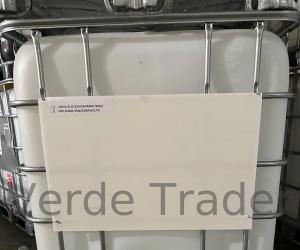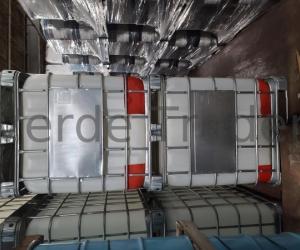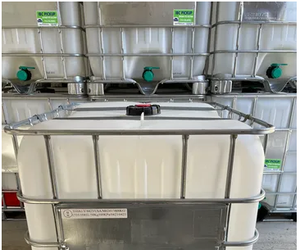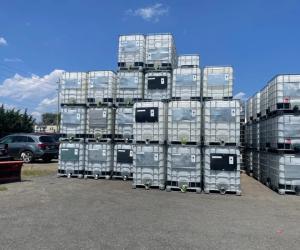- Home
- IBC Totes For Sale
IBC Totes (Intermediate bulk containers) For Sale
New Bottle & Refurb Cage
Rebottled IBC Totes
View Rebottled Totes →Refurbished Cage & Bottle
Reconditioned IBCs
View Reconditioned IBCs →As is Cage & Bottle
Used IBC Totes
View Used IBC Totes →Rinsed IBC Totes
View Rinsed IBC Totes →Caged IBC Totes For Sale
Caged IBC totes are versatile, highly mobile containers used for the transport, storage, and handling of liquid and solid chemicals. Transportability is a key feature of caged IBC totes. Integrated shipping pallet bases with rigid steel frames provide structure protection for IBCs that feature plastic tanks.
Rebottled
Rebottled totes contain new HDPE bladders, and the outer protective cages were previously used but have been refurbished and inspected in compliance with industry standards.
Reconditioned
Reconditioned IBC have a previously used inner HDPE liner and reconditioned steel cage frames. Reconditioned IBCs undergo regulation-based cleaning and inspection to ensure they meet and exceed requirements for use. Note, reconditioned IBC totes are not approved for potable water and consumables due to prior use. This option is the least expensive caged IBC model.
Used
Used IBCs that have been filled at least once. They vary in cleanliness and are usually not recommended for new tote users.
Frequently Asked Questions
What is an IBC tote?
The caged IBC Tote serves as a versatile and highly mobile container for transporting, storing, and handling liquids. Their cage is manufactured from galvanized steel, while their HDPE bottle features a 6" inlet and 2" outlet.
Are they stackable?
The containers are designed to be stacked two high with products inside and up to four high empty.
What are they used for?
Various liquid products are transported and stored in cage IBC Totes, such as adhesives, edible ingredients, agriculture products, oil gas products, and hazardous chemicals.
What are IBC totes made of?
Galvanized steel makes up the cage, while BPA HDPE makes up the bladders.
What are the dimensions of IBC Totes?
275 Gallon - 40″L x 48″W x 46″H & 330 Gallon - 40″L x 48″W x 54″H
Can IBC Totes be used for potable water?
It is possible as long as the IBC tote has never been used for anything else. For potable water, only use IBC totes with never-before-used HDPE bladders.
How long do IBC totes last?
If the steel cage of the container is not damaged and they aren't left sitting in the sun, IBC containers have a very long shelf life. In accordance with DOT regulations, a used IBC tote must be recertified every two years.
How much do empty IBC totes weigh?
Empty containers weigh between 130 lbs and 150 lbs.
How many fit on a truck?
A truck can carry 60 empty totes. Trucks can typically carry 10 to 14 full containers before reaching their capacity of 40,000 pounds.
Are the bottles bpa free?
Yes, the HDPE bladders are BPA free.
How much do IBCs cost?
IBC totes can range in price from $35.00 to $400.00 depending on their condition. In spite of the wide price range, reconditioned totes typically cost about $140 dollars, and rebottled totes usually cost around $200. Prices vary from $250 to $400 for new totes, depending upon the quantity purchased.
IBC Tote Construction
IBC manufacturers follow a global uniform standard, which are in compliance with international packaging regulations governing the transport of dangerous goods and meet customer’s requirements regarding stability, functionality, and packaging reliability.
IBC containers are typically made of at least 5 modular components and may come with additional service equipment and/or external markings.
Inner HDPE “Bladder, Bottle, or Tank”
All bottles are blow-molded with a high-density polyethylene (HPDE) interior and post consumer resin (PCR) exterior.
HDPE is an industrial strength, durable plastic that is resistant to the corrosive effects of many chemicals. It does not rust and can resist impacts, punctures, and tears. It is also FDA food grade approved and ANSI / NSF 61 certified for consumables and potable water.
IBC bottles are BPA free and FDA approved.
The bottles have multiple layers and a permeation barrier, preventing contaminants from outside going in, and keeping the fillings from inside coming out.
Bladder certification
Plastic IBC totes are heavily regulated by federal (Title 49 CFR), state, and local governments because of the different material they can be filled with. These regulations help create totes that are safe, effective, efficient tools for bulk materials to minimize work efforts as well as employee and public hazards.
Each composite IBC intended for use according to the DOT Regulations and UN Model Recommendations shall bear visible markings.
If an IBC has a visible UN certification marking, it must comply with all respects of the DOT and UN requirements irrespective of whether or not hazardous materials are to be transported. These markings are internationally recognized.
UN Certified
- A UN-approved stamped bottle means the bottle is safe and efficient to use for regulated products, hazardous materials, and dangerous and sensitive filling goods.
- UN-approved bottles are allowed to be filled with high-density filling goods up to 1.9 kg / liter.
- High-Level UN-approved bottles can be filled with even denser goods up to 1.6 kg / liter, and can be filled at lower temperatures.
Non-UN
- Bottles can also be non-UN stamped, meaning it is safe and efficient to use for non-regulated, non-hazardous materials
Galvanized Steel Frame or Cage
The plastic bladder or bottle is wrapped in a zinc-coated and galvanized steel cage which helps secure the bottle to the pallet and protects it during storage and transport.
The cage allows the unit to withstand dynamic and static loads and also allows it to be stacked vertically to save space.
IBC Pallet Types
IBCs feature an integrated, composite type pallet base that simplifies product movement and increases mobility. High molecular HDPE and galvanized steel are used for constructing the composite base. The HDPE bottle is supported by a flat steel plate on the unified skid. Forklifts and pallet jacks can operate caged IBC tote pallets due to their four-way and multidirectional steel access channels. From these access channels, one can approach and maneuver a tote from each direction.
Composite pallets
- The “standard” solution and they come in frames, skids, and ISO container forms. These pallets are made of a combination of steel and plastic, ideal for impact resistance and handling over the long-term. Composite frames are stiffer for better high-rack performance, and have less pan sagging from the weight of the bottle and its fillings.
Plastic pallets
- The “sophisticated” solution and there is only one type. Typically they are a single-piece injection molded made of light or recycled plastics. Their lighter weight makes them easier to handle compared to composite pallets. They are extra hygienic and aren’t prone to contamination making them ideal for moving food quality contents and pharmaceutical products.
Wooden pallets
- The “economic” solution and come in the same forms as Composite pallets. They are robust, easy to handle, and offer high rigidity. The standard frames are the simple cost-effective option, but have a short shelf life as wood starts to deteriorate.
Inlets & Outlets
For valves and caps, a variety of sizes and fittings are available to meet the needs of most consumers – NPT valves and cam lock valves are the most popular.
Inlets/Fill Cap Options
- 6″ Black Solid Cap
- 6″ Blue Top Fill Port Cap, 2″ Buttress Plug, EPDM Gasket
- 6″ Top Fill Port Screw Cap, 2″ NPT Plug for IBC Totes
Outlets/Valve Options
- 2″ NPT Ball Valve for 62mm IBC Tote Outlets w/Cap and Plastic Collar
- 2″ Camlock Ball Valve for 62mm IBC Tote Outlets w/Cap and Plastic Collar
- 2″ Camlock Anti-Backflow Ball Valve for 62mm IBC Tote Valve Outlets w/Cap and Plastic Collar
IBC Tote Dimensions
275 Gallon IBC Tote Tanks Dimensions
- Dimensions: 40″L x 48″W x 46″H
- 60 Empty 275 Gallon fit in a 53’ dry van container
- Weight: 135 lbs
330 Gallon IBC Tote Dimensions
- Dimensions: 40″L x 48″W x 54″H
- 60 Empty 330 Gallon fit in a 53’ dry van container
- Weight: 150 lbs
IBC Advantages & Characteristics
Since caged IBC Totes are intermediate bulk containers designated for the handling, storage, and transportation of liquid and/or granulated materials. The temperature, air, and water in an environment are capable of damaging chemicals and other commodities. Caged IBC containers can safely transport these commodities without experiencing any degradation. It is possible to store products with limited risk and minimize waste caused by potential leaks, spills, and overflows
- Cost effective industrial-sized storage tanks
- Efficient uses of space
- Can be reused multiple times
- Optimal form factor to cylindrical drum containers
Engineered for transportation & storage:
Totes have additional perks over barrels that allow for easier use.
- Interlocking grooves made for stacking allows for a greater storage capacity
- 4 way pallets for easy forklift and pallet jack access
- Less labor & materials is required for storing and transporting
Increased Capacity
Typically 55 gallon barrels are transported 4 per skid. Four barrels on a 48 x 40 is almost identical in size as one IBC Tote.
- Four 55 gallon barrels = 200 Gallons (757.082)
- One 275-gallon tote (1000 liters) = Five 55-gallon drums
- One 330-gallon tote (1250 liters) = Six 55-gallon drums
- Thus achieving a minimum increase of 20% in volume
Empty totes are stackable 3 – 4 high, while filled totes are safely stackable up to 2 high
Verde Trader & IBC Tote Recycling
Since 2017, IBC Tote Recycling & Verde Trader has been delivering quality service to manufacturers and consumers alike. We offer the largest selection of used IBC totes and work with IBC recyclers across the country in order to help recycle bulk containers responsibility.
Local Suppliers of IBC Totes Near You
Verde Trader is a used industrial packaging marketplace. Our goal is to service companies all of sizes.















